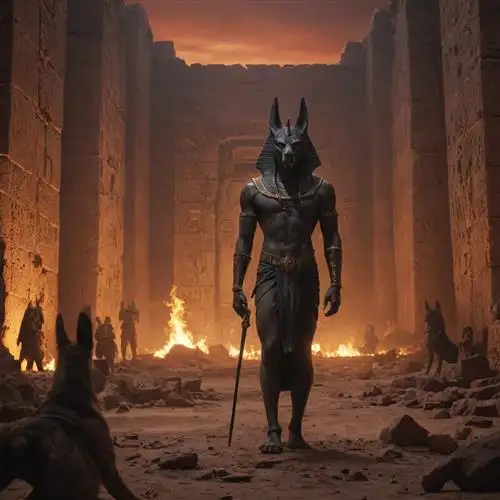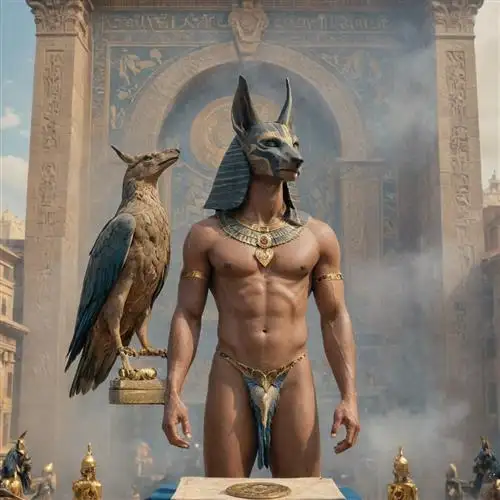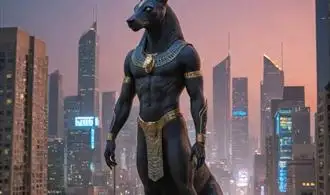
The Symbolism of Anubis Head
Anubis, the ancient Egyptian god of the dead, is often depicted with the head of a jackal or wild dog. This distinctive iconography is rich with meaning and symbolism, offering valuable insights into the role and significance of Anubis within the Egyptian pantheon. The jackal-headed figure of Anubis is a striking and instantly recognizable representation, and understanding the deeper symbolism behind this imagery can greatly enhance our appreciation of this powerful deity.
The jackal was a sacred animal in ancient Egypt, closely associated with the afterlife and the transition from life to death. Jackals were often seen near cemeteries and burial sites, scavenging the dead, and this connection to the world of the dead made them a fitting symbol for Anubis, the god who presided over the embalming process and the journey of the soul into the afterlife. The jackal's sharp senses and ability to navigate the darkness of the night also aligned well with Anubis's role as a guide and protector of the dead.
Beyond the jackal symbolism, the head of Anubis is also significant for its resemblance to the profile of a human face. This duality, combining the animal and the human, is a common theme in Egyptian mythology and speaks to the liminal nature of Anubis's domain – the space between the living and the dead, the physical and the spiritual. The human-like features of Anubis's head suggest a connection to the mortal realm, while the animalistic qualities remind us of the primal, instinctive forces at work in the process of death and rebirth.
The prominence of the head in Anubis's iconography is also highly symbolic, as the head was seen as the seat of the soul and the locus of divine wisdom and power in ancient Egyptian belief systems. By depicting Anubis with a prominent, oversized head, the ancient Egyptians were emphasizing the god's profound knowledge and authority over the mysteries of the afterlife. Why Anubis Rituals are the Key to Unlocking Your Spiritual Power explores this concept in greater depth, examining the role of Anubis-focused rituals in accessing deeper spiritual insights and powers.
Anubis in the Underworld
Anubis, the jackal-headed Egyptian deity, was a pivotal figure in the Underworld. As the god of embalming and the afterlife, Anubis played a crucial role in guiding the deceased through the complex journey of the afterlife. His iconography and symbolism were deeply intertwined with the Underworld, offering a wealth of insights into ancient Egyptian beliefs and practices.
At the heart of Anubis's association with the Underworld was his role as the overseer of the mummification process. As the god of embalming, Anubis was responsible for the careful preparation of the deceased, ensuring that the body was properly preserved and ready for the next stage of the journey. This process was not merely a physical one, but a deeply spiritual undertaking, as Anubis invoked the divine powers to protect the soul of the deceased and guide it through the perilous Underworld.
The Underworld, known as the Duat, was a complex and multifaceted realm, and Anubis was a central figure in navigating its treacherous landscape. As the guardian of the deceased, Anubis was responsible for guiding the soul through the various checkpoints and trials that stood between the mortal world and the afterlife. This included the weighing of the heart, a critical event where the deceased's deeds and moral character were evaluated to determine their worthiness for eternal life.
Anubis's iconography further reinforced his association with the Underworld. The jackal or dog-like features of Anubis were believed to represent his role as a protector and guide, as these animals were often associated with the ability to navigate the boundaries between the living and the dead. Additionally, Anubis's black color was symbolic of the fertile soil of the Nile Valley, which was believed to be the source of life and rebirth in the afterlife.
The importance of Anubis's role in the Underworld extended beyond the individual's journey. He was also responsible for maintaining the cosmic order and balance within the Duat, ensuring that the delicate balance between the living and the dead was maintained. This included overseeing the judgment of the dead, as well as the preservation of the eternal cycle of life, death, and rebirth that was so central to ancient Egyptian beliefs.
Anubis and the Weighing of the Heart
Anubis and the Weighing of the Heart is a pivotal concept in ancient Egyptian mythology, offering profound insights into the beliefs and practices surrounding the afterlife. As the jackal-headed god associated with mummification and the underworld, Anubis played a crucial role in the judgement of the dead, overseeing the ritual of the "Weighing of the Heart."
This ritual took place in the Hall of Judgement, where the deceased's heart was weighed against the feather of Ma'at, the goddess of truth and justice. Anubis was responsible for conducting this sacred process, ensuring the deceased's heart was pure and unburdened by sins or misdeeds. The heart was believed to be the center of the soul, containing the individual's moral essence and actions during their lifetime.
If the heart balanced perfectly with the feather, it was considered pure, and the deceased was granted passage to the afterlife. However, if the heart was heavier, outweighed by the feather, it was deemed impure, and the individual faced devastating consequences. In such cases, the heart would be devoured by the devouring monster Ammit, a composite creature with the head of a crocodile, the body of a lion, and the hindquarters of a hippopotamus.
The significance of the Weighing of the Heart ceremony cannot be overstated. It represented the ancient Egyptians' profound belief in the importance of living a virtuous and ethical life, as the outcome of this ritual would determine the deceased's fate in the afterlife. The presence of Anubis, the protector of the dead, ensured the fairness and impartiality of the judgement, making him a central figure in the Egyptian conception of the afterlife.
Anubis Iconography in Ancient Egyptian Art
Anubis, the jackal-headed god, was a crucial figure in ancient Egyptian mythology, closely associated with the funerary rituals and the afterlife. His iconic imagery pervaded various forms of ancient Egyptian art, serving as a powerful symbol of the divine and the sacred. Delving into the rich tapestry of Anubis iconography provides invaluable insights into the beliefs, practices, and cultural significance of this enigmatic deity.
One of the most distinctive features of Anubis iconography is the jackal or canine head, which is believed to represent the animal's role as the guardian of the necropolis and the protector of the dead. This distinctive head adorns numerous statues, reliefs, and funerary objects, serving as a visual identifier of Anubis's presence and influence within the ancient Egyptian pantheon.
Beyond the iconic head, Anubis is often depicted holding various ritual objects, such as the crook and flail, which were symbols of kingship and divine authority. These objects, combined with the deity's posture and attire, further reinforced his role as a guardian and intermediary between the living and the dead. Additionally, Anubis was sometimes portrayed sitting or standing, with his hands outstretched in a protective or welcoming gesture, emphasizing his role as a benevolent guide for the deceased.
The placement and positioning of Anubis within ancient Egyptian art also held deep significance. In funerary contexts, the god was often depicted guarding the entrance to the tomb or accompanying the deceased on their journey to the afterlife. This strategic placement underscored Anubis's role as the gatekeeper to the realm of the dead, ensuring the safe passage of the soul from this world to the next.
Interestingly, Anubis's iconography also evolved over time, with variations in his depiction reflecting the changing cultural and religious dynamics of ancient Egypt. For instance, during the New Kingdom period, Anubis was sometimes shown with a human body and a jackal head, blending the divine and the mortal in a symbolic representation of the god's intermediary role.
Interpreting the Jackal Symbolism of Anubis
The Egyptian god Anubis, often depicted with the head of a jackal, holds immense significance in ancient Egyptian mythology. The jackal symbolism associated with Anubis is rich in meaning and offers valuable insights into the deity's multifaceted roles and responsibilities. Delving into the iconography and symbolism of the jackal can shed light on Anubis's connection to the underworld, mummification, and the afterlife.
Jackals were a common sight in the deserts of ancient Egypt, and their nocturnal nature and association with cemeteries and burial grounds made them an apt representation of Anubis, the god who presided over the embalming process and the afterlife. The jackal's keen senses and ability to navigate the liminal spaces between the world of the living and the dead were seen as metaphors for Anubis's role as a guide and gatekeeper to the afterlife.
The jackal's instinctive behavior, such as its tendency to scavenge and feed on the dead, further reinforced its connection to the underworld and the processes of death and decay. In ancient Egyptian belief, Anubis was responsible for overseeing the mummification of the deceased, ensuring their successful transition to the afterlife. The jackal's association with these rituals and its ability to traverse the boundary between the physical and spiritual realms made it a powerful symbol of Anubis's role as a funerary deity.
Furthermore, the jackal's sharp senses and keen eyesight were also seen as symbolic of Anubis's role as a protector and guide. The deity was believed to be able to see into the afterlife, guiding the deceased through the challenging journey and ensuring their safe passage to the realm of the dead. This perception of Anubis as a watchful, vigilant guardian further reinforced the jackal's symbolic significance.
In addition to its funerary associations, the jackal symbolism of Anubis also connected the deity to concepts of judgment and the weighing of the soul. Anubis was responsible for overseeing the critical moment when the deceased's heart was weighed against the feather of truth, determining their worthiness to enter the afterlife. The jackal's role as a symbolic representation of this pivotal judgment process underscored Anubis's importance as a gatekeeper and arbiter of the afterlife.
















